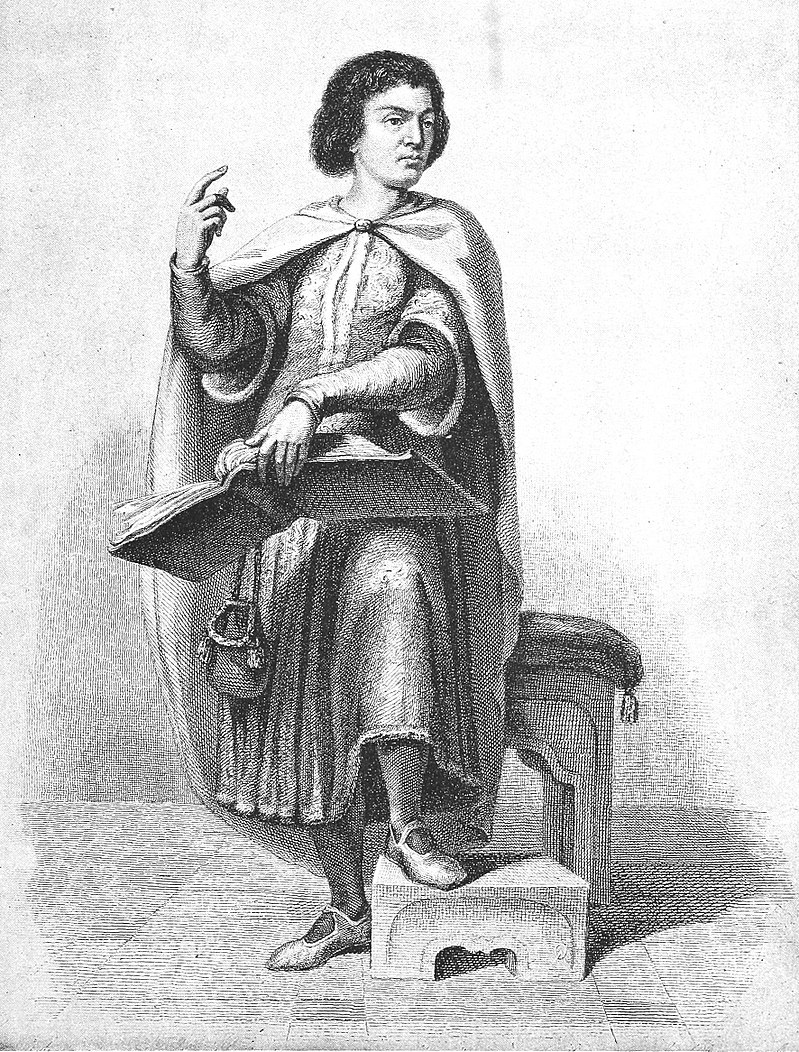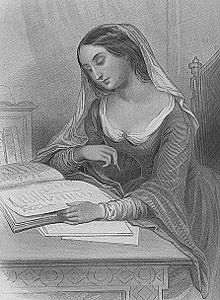When a Priest Loves a Nun | History of Love
Forbidden romances are always thrillingly intriguing. Whether they're forbidden due to social norms, class differences, racial tensions, parents disapproval, spousal disapproval, or religious conflicts they never fail to capture our attention. Maybe it's the scandals these romances produce. Maybe it's the perseverance of the story's heroes that warm our hearts with anticipation and excitement.
What's even better about forbidden romances is the layers of forbidden-ness. Yes, I'm talking layers. It's not enough that they're unmarried. It's not enough that there's an age gap. It's not enough that there's an obvious power imbalance. It's not enough that one of them's a priest and the other (eventually) becomes a nun. The sheer amount of 'rule' breaking this infamous couple went through to be together is almost comical. So let's take a dive into history's favorite rule breakers:
Like any good romance, our tale first begins in France in 1079. A good time 1079. William the Conqueror had been King of England for the past eight years. King Philip I of France was living his best life as any King of France can before the guillotine came along. And in the little western village of Le Pallet one half of our duo was born; Pierre Abelard (aka Peter).
As the eldest son of Sir Berenger, Abelard was encouraged to study the arts and academia (excelling in the Greek philosophies namely Aristotle and dialectic). Because of his pursuit in academia instead of a military career Abelard traveled! And boy did he travel! (Y'know for a minor noble French man in the 1000s).
During this time between 1090 or 1100 our second half of the duo is born; Heloise d'Argenteuil. It is not known who were her immediate family members (many speculate she was from the Garlande family). What we do know is that she had an uncle in Paris, Father Fulbert (oh and he comes back into the story, just you wait). While Heloise was being born or growing up our boy Abelard in his travels has come to Paris to study in Notre-Dame (not yet the infamous cathedral we know it as now but the first version). While studying in Notre-Dame he learns under William of Champeaux (considered to be a founder of moderate realism and HUGE influencer of Abelard and thus Heloise.)
Between 1102 and 1104 Abelard gets tired of Notre-Dame and moves to Melun creates his own school, leaves to Corbeil and creates another school. As you do. So for about thirteen years, Abelard travels about France, visits William a couple of times, visits his abandoned school in Melun then eventually comes back to Notre-Dame where Father Fulbert and his young niece Heloise. Abelard due to his excelling academia and devotion to theology and the Catholic church becomes a master of Notre-Dame a canon of Sens, aka a Priest of the archdiocese in Paris. If you're not Catholic or weren't raised so this basically means he's part of the Bishop of Sens' crew, more or less. So now Abelard is a priest. A holy man. One devoted to God, the church, the people, and chastity.
Abelard continues to teach during this time earning the trust of Fulbert who sent Heloise to be Abelard's student. Greatest Uncle/Accidental Matchmaker goooooesss to... FULBERT! As already revealed in the title Heloise and Abelard do become lovers at this time. What I love about their relationship is that because of Heloise's interest and knowledge in medicine, Abelard and her were able to come together (he he) and form one of the most scandalous relationships in HISTORY. As with all great things some idiot with a big mouth (read: Abelard) went around to his colleagues (read: priests and cohorts) about his 'conquest' of Heloise. I can't stress enough how much of a complete buffoon you have to be to brag about your sexual exploits when you're a priest!
'Hey, 1115 was a different time', you might say. A different time, but not quite.
You see the thing about bragging about your exploits to a bunch of priests is that 1) THEY'RE PRIESTS, and 2) a bunch of dudes learning and preaching about Jesus find some hot dirt on their coworker... Um hello!?! Gossip is coming.
And with gossip in the 1110's also came Uncle Fulbert separating the two. As the saying goes, you can't keep a good dog (read: Abelard) down and Heloise and her good dog continued their affair which landed the two into a pregnancy. At this point, she was sent to Abelard’s family in Le Pallet (Brittany) and she gave birth to their son, Astrolabe. And y'all thought Moon Unit was a spicy bit of gossip back in the day. Girl, please!
What's even better about forbidden romances is the layers of forbidden-ness. Yes, I'm talking layers. It's not enough that they're unmarried. It's not enough that there's an age gap. It's not enough that there's an obvious power imbalance. It's not enough that one of them's a priest and the other (eventually) becomes a nun. The sheer amount of 'rule' breaking this infamous couple went through to be together is almost comical. So let's take a dive into history's favorite rule breakers:
Abelard and Heloise
 |
| Tres Romantique! |
Like any good romance, our tale first begins in France in 1079. A good time 1079. William the Conqueror had been King of England for the past eight years. King Philip I of France was living his best life as any King of France can before the guillotine came along. And in the little western village of Le Pallet one half of our duo was born; Pierre Abelard (aka Peter).
 |
| That time Abelard was a fashion model |
During this time between 1090 or 1100 our second half of the duo is born; Heloise d'Argenteuil. It is not known who were her immediate family members (many speculate she was from the Garlande family). What we do know is that she had an uncle in Paris, Father Fulbert (oh and he comes back into the story, just you wait). While Heloise was being born or growing up our boy Abelard in his travels has come to Paris to study in Notre-Dame (not yet the infamous cathedral we know it as now but the first version). While studying in Notre-Dame he learns under William of Champeaux (considered to be a founder of moderate realism and HUGE influencer of Abelard and thus Heloise.)
Between 1102 and 1104 Abelard gets tired of Notre-Dame and moves to Melun creates his own school, leaves to Corbeil and creates another school. As you do. So for about thirteen years, Abelard travels about France, visits William a couple of times, visits his abandoned school in Melun then eventually comes back to Notre-Dame where Father Fulbert and his young niece Heloise. Abelard due to his excelling academia and devotion to theology and the Catholic church becomes a master of Notre-Dame a canon of Sens, aka a Priest of the archdiocese in Paris. If you're not Catholic or weren't raised so this basically means he's part of the Bishop of Sens' crew, more or less. So now Abelard is a priest. A holy man. One devoted to God, the church, the people, and chastity.
 |
| That time Heloise didn't care |
'Hey, 1115 was a different time', you might say. A different time, but not quite.
You see the thing about bragging about your exploits to a bunch of priests is that 1) THEY'RE PRIESTS, and 2) a bunch of dudes learning and preaching about Jesus find some hot dirt on their coworker... Um hello!?! Gossip is coming.
 |
| I mean, this one is just gold. Uncle Fulbert is NOT PLEASED! |
However, because the church was such an entity of prosperity built on prestige and hierarchy (much like the nobility they so often served) Fulbert proposed a secret marriage for Abelard and Heloise so that both Fulbert and Abelard's careers weren’t tarnished by their sinful ways. (The men in this tale are top notch, let me tell you!) Heloise opposed the marriage. She went on to write (no less a co-author WITH Abelard), that "I preferred to love to wedlock, freedom to a bond"1. Following that up with,
Abelard even addressed her misgivings about the marriage in Chapter 7 of their book by saying:
"She, however, most violently disapproved of this, and for two chief reasons: the danger thereof, and the disgrace which it would bring upon me... What penalties, she said, would the world rightly demand of her if she should rob it of so shining a light!"
(Methinks Heloise would've made a great politician given the chance. Also, this whole book is a fantastic read.)
However, because this tale takes place in the 1110's, Abelard and Heloise are eventually married in secret, because we don't want to hurt Abelard's career now. Then when Fulbert announced the marriage (why can’t any of you keep a secret???) Heloise denied it and Abelard sent her to a convent in Argenteuil to protect her from her uncle’s wrath. Heloise dressed in the habit and lived as a nun but she was never veiled as such. Due to the sudden hiding of Heloise Fulbert believed Abelard was ashamed of her and sent a band of men to his room at night to castrate him. As you do.
In the morning after suffering through the attack, the city of Paris now knew his humiliation and ridiculed him for it. Including his fellow clergymen. From Chapter 8, Abelard wrote about the situation,
"What path lay open to me thereafter? How could I ever again hold up my head among men, when every finger should be pointed at me in scorn, every tongue speak my blistering shame, and when I should be a monstrous spectacle to all eyes? I was overwhelmed by the remembrance that, according to the dread letter of the law, God holds eunuchs in such abomination that men thus maimed are forbidden to enter a church, even as the unclean and filthy; nay, even beasts in such plight were not acceptable as sacrifices...
Now fast forward to a couple of years to April of 1129 when the whole convent of Argenteuil was expelled and Heloise became the head of a new foundation called Paraclete. This is where our two lovers meet once more as Abelard became the abbot of Paraclete. In the early 1130s Heloise and Abelard in an effort to expand literacies composed a collection of their own love letters and religious correspondence. This is how they gained fame and have encaptured people with their own tales for hundreds of years in the form of Historia Calamitatum. They were the first lifestyle bloggers of their day.
During these times Abelard continued his oratory lectures and also getting himself into trouble by calling other's heresies. To the point where Pope Innocence II excommunicated Abelard and his followers and demanded Abelard be silenced in a monastery and his books burned. Barely saved by this fate about a year later on April 21, 1142, Abelard died of fever and a skin disorder thought to be scurvy near Chalon-sur-Saône. His last words rumored to be, "I don't know." (Wow, it's me!) Heloise had him buried in Paraclete where she was later laid to rest beside him in 1163.
Thanks to them, we have a better understanding of the time period and their ideologies, even if they weren't common for the day like Heloise. (She was very radical for her day and is endlessly fascinating. I might even do a whole post on just her philosophies and ideals.) If you have the time to read even a little bit of their writings you'll see how we've been influenced by these two in our understanding of the 1100's, love, tradition, French society and philosophy, naming your kids after objects, and ideals.
Maybe we, as a culture, love forbidden romances' because of the struggles that go along with them. Maybe it's the human emotions that make their plight so endearing. Maybe it's with those struggles and emotions we end up getting these amazing works such as Historia Calamitatum that show us what life was like that we wouldn't have had otherwise. As a certified history nerd and lover of romances, this infamous story of a nun shacking up with a priest is one for the books.
Sources and further reading:
Assuredly, whomsoever this concupiscence leads into marriage deserves payment rather than affection; for it is evident that she goes after his wealth and not the man, and is willing to prostitute herself, if she can, to a richer.1
 |
| One of my favorite painting's of the two |
"She, however, most violently disapproved of this, and for two chief reasons: the danger thereof, and the disgrace which it would bring upon me... What penalties, she said, would the world rightly demand of her if she should rob it of so shining a light!"
(Methinks Heloise would've made a great politician given the chance. Also, this whole book is a fantastic read.)
However, because this tale takes place in the 1110's, Abelard and Heloise are eventually married in secret, because we don't want to hurt Abelard's career now. Then when Fulbert announced the marriage (why can’t any of you keep a secret???) Heloise denied it and Abelard sent her to a convent in Argenteuil to protect her from her uncle’s wrath. Heloise dressed in the habit and lived as a nun but she was never veiled as such. Due to the sudden hiding of Heloise Fulbert believed Abelard was ashamed of her and sent a band of men to his room at night to castrate him. As you do.
In the morning after suffering through the attack, the city of Paris now knew his humiliation and ridiculed him for it. Including his fellow clergymen. From Chapter 8, Abelard wrote about the situation,
"What path lay open to me thereafter? How could I ever again hold up my head among men, when every finger should be pointed at me in scorn, every tongue speak my blistering shame, and when I should be a monstrous spectacle to all eyes? I was overwhelmed by the remembrance that, according to the dread letter of the law, God holds eunuchs in such abomination that men thus maimed are forbidden to enter a church, even as the unclean and filthy; nay, even beasts in such plight were not acceptable as sacrifices...
I must confess that in my misery it was the overwhelming sense of my disgrace rather than any ardour for conversion to the religious life that drove me to seek the seclusion of the monastic cloister. Heloise had already, at my bidding, taken the veil and entered a convent. Thus it was that we both put on the sacred garb, I in the abbey of St. Denis, and she in the convent of Argenteuil, of which I have already spoken.
 |
| And y'all thought I was wordy |
 |
| This looks like a cover of an 1800's romance novel |
Thanks to them, we have a better understanding of the time period and their ideologies, even if they weren't common for the day like Heloise. (She was very radical for her day and is endlessly fascinating. I might even do a whole post on just her philosophies and ideals.) If you have the time to read even a little bit of their writings you'll see how we've been influenced by these two in our understanding of the 1100's, love, tradition, French society and philosophy, naming your kids after objects, and ideals.
Maybe we, as a culture, love forbidden romances' because of the struggles that go along with them. Maybe it's the human emotions that make their plight so endearing. Maybe it's with those struggles and emotions we end up getting these amazing works such as Historia Calamitatum that show us what life was like that we wouldn't have had otherwise. As a certified history nerd and lover of romances, this infamous story of a nun shacking up with a priest is one for the books.
Until Next Time,
- Peter Abelard: Historia Calamitatum
- Abelard and Heloise- Their Story
- Abelard and Heloise: The Legacy of Historic Lovers
- The Love Letters of Abelard and Heloise
- Peter Abelard
- Abelard and Heloise: A Medieval Love Story
- Icons of the Middle Ages: Rulers, Writers, Rebels, and Saints
This video took 30 hours to upload 👀 Show it some love?
❤CJ❤










Bet on Baccarat - Wagrione
ReplyDeleteThis worrione is where the term 'betting septcasino on horse racing' comes from. The term is simply “how horses bet'. It refers to the number of horses that 메리트카지노총판 win the race or